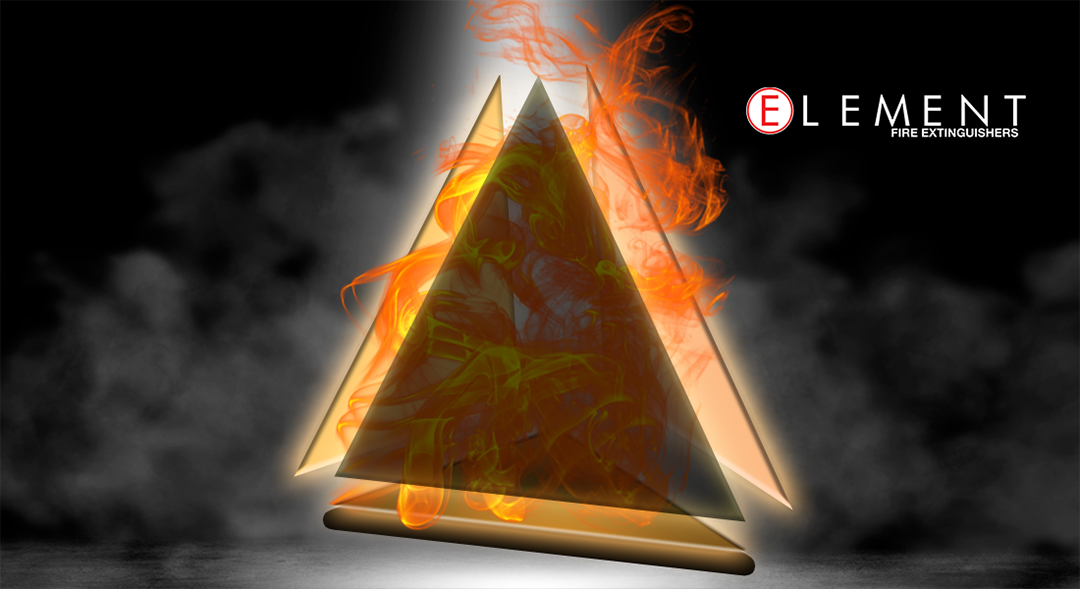Everyone should have a basic understanding of the fire tetrahedron, otherwise known as the fire triangle. Understanding the fire tetrahedron is important since each day we are all at some risk of being present during a fire and we need to know how to react. The National Fire Protection Association (NFPA) reported in 2018 alone “fire departments responded to an average of 470 home cooking fires per day.” Those are just kitchen fires. There are all kinds of fires that can happen around you, in your car, on your computer, in your RV and in your home.

So what is the fire tetrahedron or fire triangle? The fire triangle is the concept that fires require four basic components: heat, oxygen, fuel and a chain reaction. Think of the fire tetrahedron as a pyramid with each side representing one of the four components. If you remove any of the components, the fire will go out. This understanding will help you to quickly react to stop a fire should you be faced with one.
Fire Triangle Components Breakdown
Heat 🌡️: a heat source is needed for fire to occur. Everything has a point at which it will combust, otherwise known as a “flash point.” This varies depending on the material. It also applies to the temperature of the fuel as the fire continues to burn.
Oxygen 💨: fire can be compared to a living thing. It needs food (fuel), heat (body temperature appropriate to sustain life) and air to breathe. Oxygen basically “feeds” a fire. As oxygen reacts with the fuel it releases carbon dioxide and heat. Removing the oxygen essentially suffocates the fire just as it would a living creature.
Fuel 🪵: fuel is the material that burns. It is essentially the hardest thing to remove from a fire, since everything around us can become fuel. Think of all the things around us that burn; clothing, furniture, paper, oil and grease etc.
Now that you understand the fire tetrahedron let’s talk about how you can interrupt it.
The Small Fire Extinguisher that Does a Big Job
When you think of fire extinguishers you probably picture the big, bulky, hard to lift canisters that take up much needed space. What if you could instead have a small fire extinguisher that does the same job as its bulky brother and might even be better? Element Fire Extinguishers are the world’s smallest fire extinguishers and even last longer than the traditional big guys.
Remember the fire tetrahedron? The chain reaction part of the fire triangle can be obliterated with this small fire extinguisher. It works by using two processes; a physical reaction and interrupting the chemical chain reaction using free radical potassium ions.
The chemical chain reaction is interrupted through potassium particles attach themselves to Oxygen and the fire’s combustion particles. That link interrupts the reaction and puts the fire out by preventing the fire from breathing. The free radical potassium ions only affect the reaction that happens within a fire without making the air unbreathable.
This small fire extinguisher is non-toxic and non-corrosive. It allows you to put out fires without causing further damage to surfaces. It never needs service or upkeep like traditional fire extinguishers and doesn’t expire. Since it is so small you can keep it anywhere allowing you to have an effective means to put out fires anywhere from your kitchen, home office, RV and vehicle.
Fire Tetrahedron FAQs
What are the four classes of fire according to NFPA?
The National Fire Protection Agency (NFPA) has defined the following 5 classes of fire:
- Class A Fire: This is any fire that involves ordinary fuel sources like paper, wood, cloth, rubber, etc.
- Class B Fire: Flammable liquid fires use oils, gas and other liquid fuels for a fire.
- Class C Fire: Is an A or B fire that also involves electricity, also called an electrical fire.
- Class D Fire: Involves burning metals like magnesium, titanium, lithium, etc.
- Class K Fire: This is a Kitchen fire. The burning fuels of a kitchen fire are oils or fats commonly used in cooking.
What is another name for the fire tetrahedron?
Many people will call the fire tetrahedron a fire triangle. While both are similar, the tetrahedron is more accurate as it captures the fourth element of the chemical reaction.
Which 3 components are needed to start a fire?
- Heat
- Oxygen
- Fuel
Each one is a necessary component of fire. A fire cannot start a triangle of combustion without the presence of all three.
How to interrupt the chemical chain reaction of fire?
To extinguish a fire, you need to remove one of the essential elements in the fire triangle, or disrupt the chemistry of a fire. Fuel and oxygen react together to sustain the fire. Element uses free radical potassium ions that attach themselves to the oxygen molecule, modifying it so the fire cannot sustain the combustion reaction. These ions modify the supply of oxygen enough so it's unusable for the fire while still being breathable (unlike halon and halotron extinguishers). Once the combustion triangle is broken, the chemical chain reaction is broken; essentially starving the fire.
What is a free radical?
In chemistry, a free radical is a molecule that contains an unpaired electron. The Element potassium radicals (K+) capture the Oxygen of the combustion thereby extinguishing the fire.


